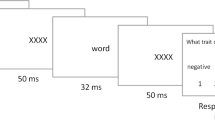Abstract
The emotional priming task was used to test between an esteem-regulation and a more general affect-regulation interpretation of a phenomenon first reported by Power and Brewin (1990). A group of normal subjects were primed with emotion terms that were related to love, fear, sadness, or anger. A target adjective was presented either 250 ms or 2000 ms later, for which the subject's task was to indicate whether or not the adjective was self-descriptive. At the longer duration for negative emotion primes, the subjects endorsed fewer negative adjectives as self-descriptive and took longer to make these endorsements. The effect, however, was obtained with all three negative emotion types and therefore both the current and previous findings are interpreted to be evidence for affect-regulation rather than more specific esteem-regulation processes.
Similar content being viewed by others
References
Beck, A. T., Ward, C. H., Mendelson, M., Mock, J. E., & Erbaugh, J. K. (1961). An inventory for measuring depression.Archives of General Psychiatry, 4, 561–571.
Bower, G. H. (1986). Prime time in cognitive psychology. In P. Eelen & O. Fontaine (eds.),Behavior therapy: Beyond the conditioning framework. Leuven: Leuven University Press/Erlbaum.
Ekman, P. (1984). Expression and the nature of emotion. In K. R. Scherer & P. Ekman (eds.),Approaches to emotion. Hillsdale, NJ: Erlbaum.
Freud, S. (1917). Mourning and melancholia. In J. Strackey (ed. and trans.),Standard Edition of the complete psychological works of Sigmund Freud (Vol. 14, pp. 239–258). London: Hogarth Press.
Ingram, R. E. (1984). Information processing and feedback: Effects of mood and information favorability on the cognitive processing of personally relevant information.Cognitive Therapy and Research, 8, 371–386.
Isen, A. (1985). Asymmetry of happiness and sadness in effects on memory in normal college students: Comment on Hasher, Rose, Zacks, Sanft, and Doren.Journal of Experimental Psychology (General), 114, 388–391.
Johnson-Laird, P. N., & Oatley, K. (1989). The language of emotions: An analysis of a semantic field.Cognition and Emotion, 3, 81–123.
Mathews, A. M., & MacLeod, C. (1985). Selective processing of threat cues in anxiety states.Behavior Research and Therapy, 23, 563–569.
Neely, J. H. (1977). Semantic priming and retrieval from lexical memory: Roles of inhibitionless spreading activation and limited-capacity attention.Journal of Experimental Psychology (General), 106, 226–254.
Norris, D. (1984). A computer-based programmable tachistoscope for nonprogrammers.Behavior Research Methods, Instruments, and Computers, 16, 25–27.
Oatley, K., & Bolton, W. (1985). A social-cognitive theory of depression in reaction to life events.Psychological Review, 92, 373–388.
Oatley, K., & Johnson-Laird, P. N. (1987). Towards a cognitive theory of emotions.Cognition and Emotion, 1, 29–50.
Power, M. J. (1986). A technique for measuring processing load during speech production.Journal of Psycholinguistic Research, 15, 371–382.
Power, M. J. (1987). Cognitive theories of depression. In H. J. Eysenck & I. Martin (eds.),Theoretical foundations of behavior therapy (pp. 235–255). Plenum Press, New York.
Power, M. J. (1990). A prime time for emotion: Cognitive vulnerability and the emotional disorders. In K. Gilhooly, M. T. G. Keane, R. H. Logie, & G. Erdos (eds.),Lines of thinking: Reflections on the psychology of thought (Vol. 2, pp. 157–165). Chichester: Wiley.
Power, M. J., & Brewin, C. R. (1990). Self-esteem regulation in an emotional priming task.Cognition and Emotion, 4, 39–51.
Segal, Z. V., & Shaw, B. F. (1988). Cognitive assessment: Issues and methods. In K. S. Dobson (ed.),Handbook of cognitive-behavioral therapies (pp. 39–81). London: Hutchinson.
Spielberger, C. D., Gorsuch, R. L., & Lushene, R. E. (1970).Manual for the state-trait anxiety inventory (self-evaluation questionnaire). Palo Alto: Consulting Psychologists Press.
Sutherland, G., Newman, B., & Rachman, S. (1982). Experimental investigations of the relations between mood and intrusive unwanted cognitions.British Journal of Medical Psychology, 55, 127–138.
Watts, F. N., McKenna, F. P., Sharrock, R., & Trezise, L. (1986). Colour naming of phobia related words.British Journal of Psychology, 77, 97–108.
Author information
Authors and Affiliations
Rights and permissions
About this article
Cite this article
Power, M.J., Brewin, C.R., Stuessy, A. et al. The emotional priming task: Results from a student population. Cogn Ther Res 15, 21–31 (1991). https://doi.org/10.1007/BF01172940
Issue Date:
DOI: https://doi.org/10.1007/BF01172940




